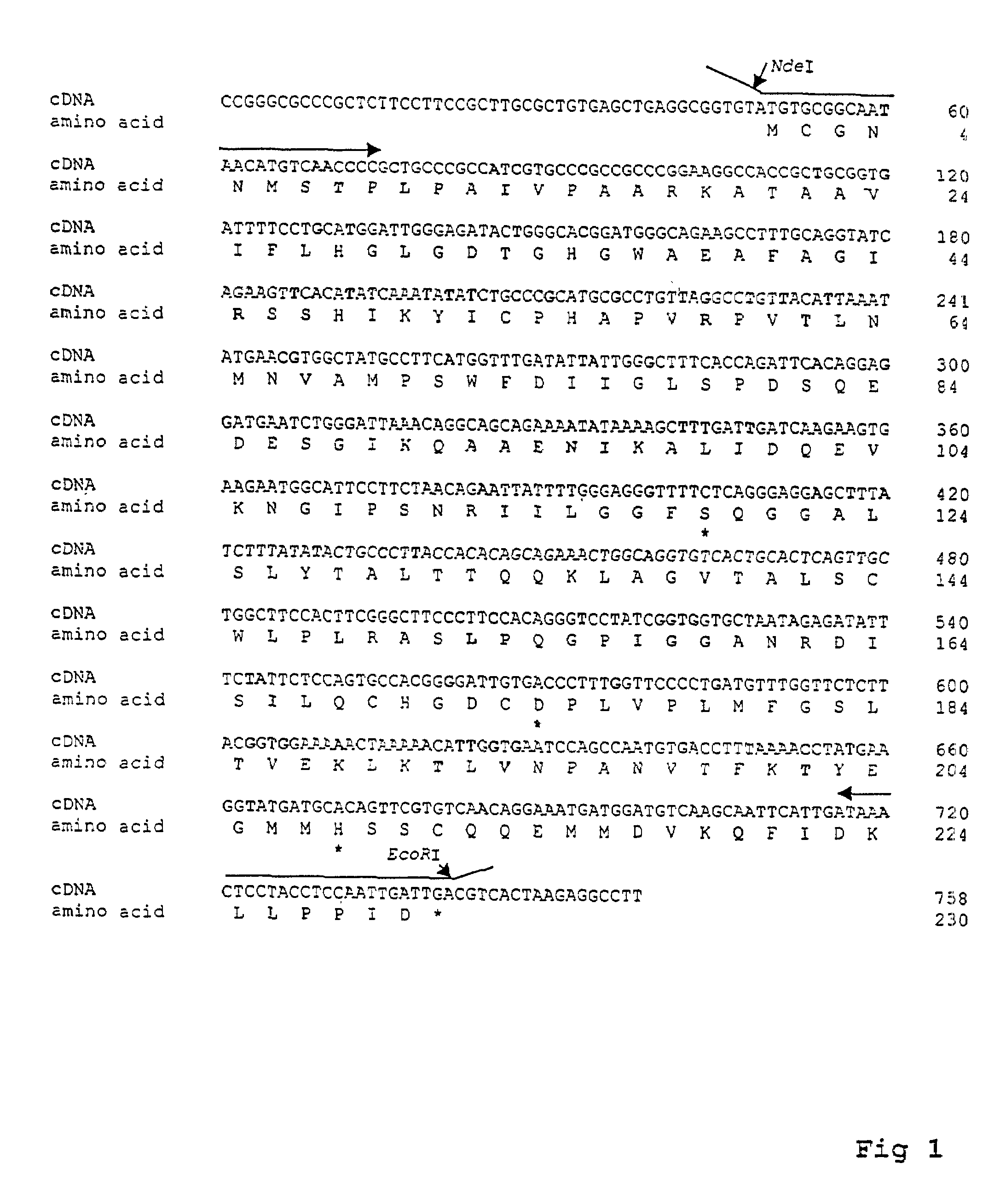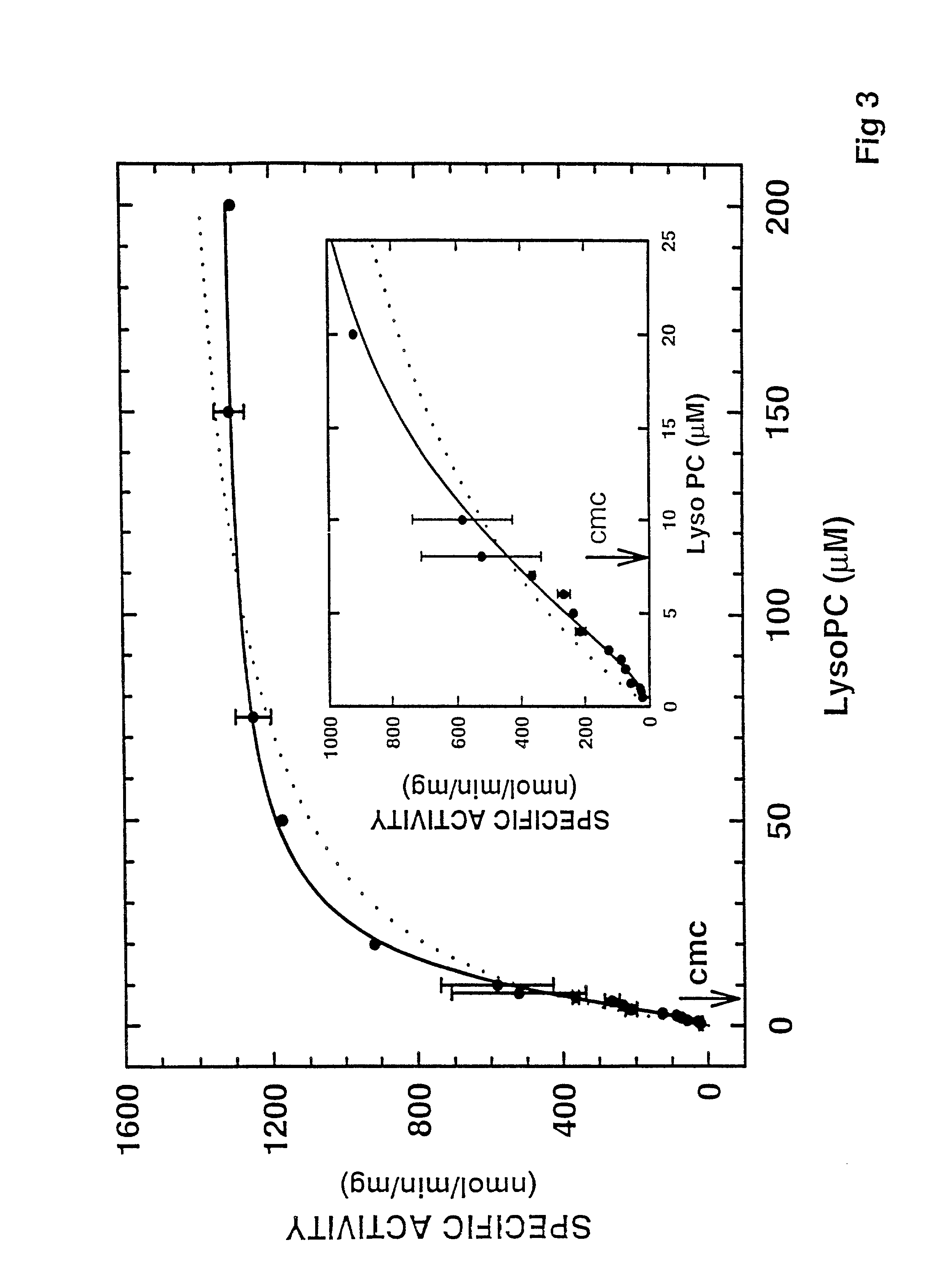Cloned human lysophospholipase
a human brain lysophospholipase and lysophospholipase technology, applied in the field of new, cloned human brain lysophospholipase, can solve the problems of cell lysis and dislocation of cell membrane integrity
- Summary
- Abstract
- Description
- Claims
- Application Information
AI Technical Summary
Benefits of technology
Problems solved by technology
Method used
Image
Examples
example 1
Cloning and Expression of hLysoPLA.
[0061]LysoPLA plays important roles in regulating the level of the multifunctional LysoPL, and several lines of evidence have suggested that LysoPLA exists in human. First, a relatively high level of LysoPLA activity has been found in human brain and it was proposed to be the major route by which LysoPL is removed from cell membranes [43]. Second, two human LysoPLAs (molecular masses of 20 and 22 kDa) have been puriced from human HL-60 cells [55]. These two enzymes appear to be the human isoforms of the mouse 27 and 28 kDa LysoPLAs. Third, when we searched DNA and protein databases in GenBank using mouse LysoPLA sequence information, several human cDNA clones were identified that match to different parts of the mouse gene Wang et al. / Biochimica et Biophysica Acta 1437 (1999) 157^169 with high homology. However, these cDNA sequences were obtained from different human tissues, their functions not identified, and none of them contained the entire prot...
example 2
Kinetic Characterization of the Recombinant hLysoPLA
[0064]To investigate the catalytic properties of the hLy-soPLA, we first determined the specific activity of hLysoPLA as a function of substrate (1-palmitoyl LysoPC) concentration. As shown in FIG. 3, the catalytic activity exhibits saturation kinetics. However, the data did not fit well to the Michaelis-Menten equation (dotted line in FIG. 3). There seems to be some cooperativity, since the data fit to the Hill equation (solid line in FIG. 3) with n=1.53 0.08, kcat=1.34 0.04 μmol / min / mg, and substrate at half-maximal saturation is 12.7±0.9 μM. Furthermore, there is no dramatic increase in the enzyme activity near the cmc of the substrate (7 μM), indicating that the enzyme hydrolyzes both monomeric and micellar substrates. This suggests that hLysoPLA is not an interfacially activated enzyme.
[0065]TX-100 is often used in the purification and stabilization of membrane-associated proteins. In addition, it is used to change the surface...
example 3
Insignificant PLA2 Activity of hLysoPLA
[0074]When we first purified the mouse LysoPLA from P388D1 cells, no other enzymatic activities (PLA1, PLA2, acyltransferase, transacylase and esterase) were found. Therefore, it appears to be a LysoPL-specific LysoPLA. Similar results were obtained for the rat LysoPLA and the relative rates towards different LysoPL substrates were reported [Sugimoto et al., (1996) J. Biol. Chem. 271, 7705-11]. However, a recently sequenced rabbit enzyme that shares high sequence homology (approx. 97%) to the rat / mouse LysoPLA was reported to have both PLA2 and LysoPLA activities [Portilla, et al., (1968) J. Am. Soc.Nephrol. 9, 1178-86]. The specific activities, however, were only 10 nmol / min / mg for PLA2 activity and 20 nmol / min / mg for LysoPLA activity. The PLA2 activity was also reported to be selective for PlsCho substrate with arachidonic acid at the sn2 position. To determine whether hLysoPLA also expresses PLA2 activity, we have explored its ability to hyd...
PUM
| Property | Measurement | Unit |
|---|---|---|
| Molar density | aaaaa | aaaaa |
| Molar density | aaaaa | aaaaa |
| Molar density | aaaaa | aaaaa |
Abstract
Description
Claims
Application Information
 Login to View More
Login to View More - R&D
- Intellectual Property
- Life Sciences
- Materials
- Tech Scout
- Unparalleled Data Quality
- Higher Quality Content
- 60% Fewer Hallucinations
Browse by: Latest US Patents, China's latest patents, Technical Efficacy Thesaurus, Application Domain, Technology Topic, Popular Technical Reports.
© 2025 PatSnap. All rights reserved.Legal|Privacy policy|Modern Slavery Act Transparency Statement|Sitemap|About US| Contact US: help@patsnap.com



